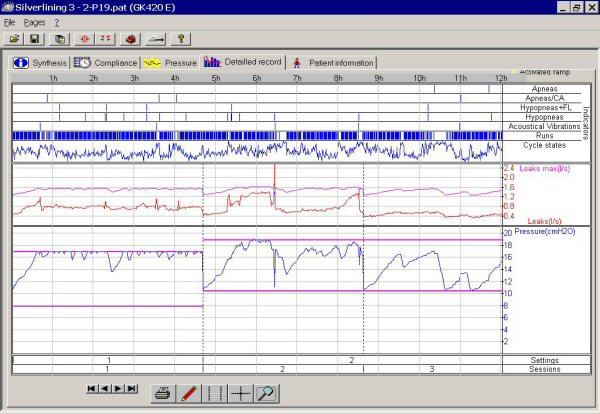Some further research on UARS - mostly easy to read.
Here is one paper from a researcher in Edinburgh UK ( albeit dated 2000) who puts the case that UARS as a condition fails to meet the required medical criteria.
(from the American Journal of Respiratory & Critical Care Medicine)
http://ajrccm.atsjournals.org/cgi/conte ... 161/5/1413
EXTRACT:
=========
>>
INTRODUCTION
The term "upper airway resistance syndrome" (UARS [1]) proved useful in highlighting deficiencies in the definition of the sleep apnea/hypopnea syndrome (SAHS). However, UARS is not distinct from SAHS, nor is there adequate evidence that UARS exists.
A syndrome is "a complex of signs and symptoms resulting from a common cause" (2). Thus, a distinct syndrome has distinct signs and symptoms. Patients with UARS usually have no signs---abnormalities on physical examination (2)---and the symptoms of UARS (1, 3) are identical to those for SAHS (4). Thus, UARS is not a distinct syndrome.
Having dismissed UARS on important semantic grounds, it is equally vulnerable medically. To be a distinct condition, it must have the following:
1. 1. Distinct diagnostic criteria
2. 2. Diagnostic criteria that are abnormal
3. 3. Diagnostic criteria that are specific
4. 4. Evidence of a causal link between the diagnostic abnormalities and clinical features (consequent morbidity)
UARS fails on all criteria.
1. DISTINCT DIAGNOSTIC CRITERIA
In the original description (1), diagnosis required sleepiness, a low apnea-hypopnea index (AHI), and frequent arousals. All reported sleepiness but no specific level of subjective or objective sleepiness was required. No subject "had obstructive sleep apnea syndrome as currently defined" but their AHI was not reported. They had to have at least 10 "short" arousals per hour slept. Esophageal pressure was not a diagnostic criterion for UARS (1). Criteria have been further complicated---not clarified---by use of differing AHI thresholds (3, 5), the introduction of esophageal pressure criteria (6, 7), and the possible use of flattening of the flow-time profile to diagnose UARS (8).
Major diagnostic confusion about UARS centers on the scoring of hypopneas. Many centers have scored hypopneas from thermal sensors. These are excellent for detecting apneas, but poor for identifying hypoventilation; exhalations of 50 and 500 ml have identical temperature. Thus, when it was recognized that hypopneas and apneas had similar consequences, and it was recommended that hypopneas should be defined by semiquantative rather than thermal techniques (9) and these now include inductance plethysmography, nasal pressure, and pneumotachography (10). Those centers that use these methods to define hypopneas rarely, if ever, classify patients as having UARS, whereas centers that rely on thermal definitions report UARS frequently (5, 6, 11).
2. DIAGNOSTIC CRITERIA MUST BE ABNORMAL
Sleepiness
The threshold for significant sleepiness is based on self-reports and nearly 20% of women and about 7% of men in the normal population report sleepiness (12). An Epworth score of > 8 has been used (3), but the normal range is up to 12 or even 15 (13).
Low AHI
The criterion of low AHI is deliberately set to define normality.
Arousal
The arousal frequency used to define UARS, > 10 per hour, is normal on the first night of polysomnography whether without (median, 16 [95% confidence interval 6-33] per hour for age < 60 yr [14]) or with (mean, 24 [SD 12] per hour [7]) the sleep-disturbing effect of esophageal pressure monitoring. Thus, it is erroneous to use > 10 arousals per hour as a cutoff for abnormality in patients undergoing polysomnography (1, 5, 6). Indeed, all patients with UARS in some studies have normal arousal frequencies at < 30 per hour (3).
Negative Pleural Pressure
The addition of criteria requiring progressive falls in esophageal pressure seemed sensible, but such falls are not synonymous with increasing resistance, and may also result from increased ventilation. A decreasing pressure over 10 s (6) may mean as few as two consecutive breaths with increasing pressure generation and normal subjects have frequent such episodes, especially during rapid eye movement (REM) sleep (15).
Thus, all four criteria are common in the normal population.
********************************************************************************************************
This researcher argues that it is a distinct medical condition ...
Look at the chapter on page 241 of this book. ... (you can increase the size of the pages using the + and - magnifying glasses in the top middle of the frame)
http://books.google.com.au/books?id=aNh ... lt#PPP8,M1
********************************************************************************************************
Also, it appears that Dr Rapoport is the person who made the association of UARS & Flow Limitations.
DSM
